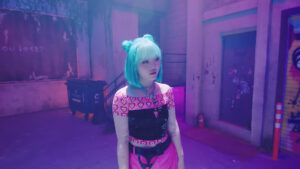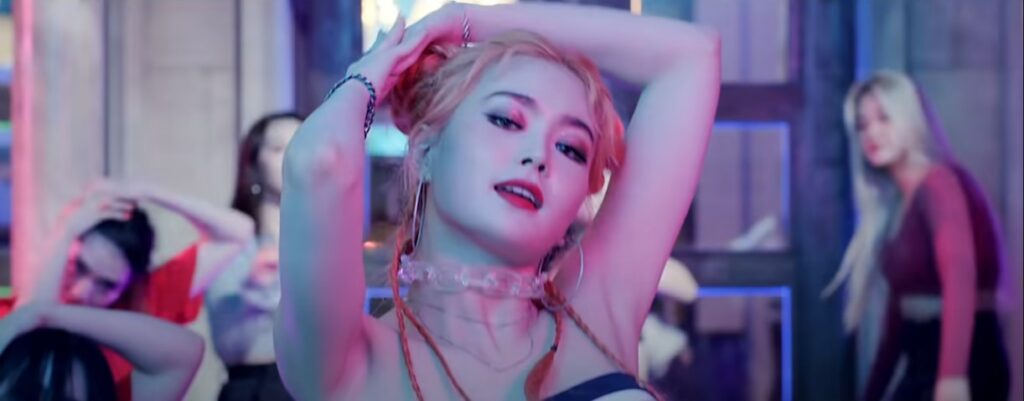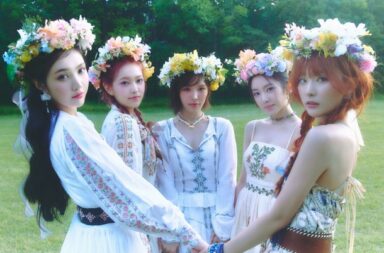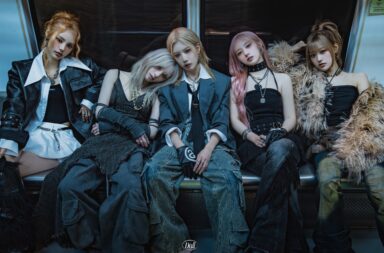
As with any other season, fall in K-pop has its own pet styles: from touches of languid bossa nova to waltz influences (Giriboy‘s “Smile, Wait for the Flash” and “Acting”, B1A4‘s “Like a Movie“) to upbeat jazzy tunes (Seventeen‘s “Home;Run“, JBJ95‘s “Jasmin”), there’s a consistent sensuality and grooviness to the music, and a certain levity that matches the crispness of the autumn air.
Despite this shared quality, though, there’s a lot of variety in the releases. For October’s Unsung Artists, we’ve compiled mini reviews of a range of MVs: vividly-coloured, delightful visual spectacles, a subdued take on the girl crush concept, and a story of heartbreak and healing with a lead actor you probably never expected.
Lee Suhyun – “Alien”
A surprise solo debut from AkMu‘s main vocalist, “Alien” is blessed with the holy K-pop MV trinity: good music, visuals that cohere with the sound, and a concept that is appropriate for the artist. (Believe this K-pop grandma, it’s not often that these three circles overlap.)
An 80s revival is on the uptick in K-pop—think Sunmi‘s “Pporappippam“, Twice‘s Eyes Wide Open, and The Midnight Romance‘s music—and “Alien” taps on the disco sounds and synthwave aesthetics of the era. The musical choice may have been incidental: perhaps Chanhyuk wanted to try his hand at the trend, and it would have been too big a leap for AkMu to release, as they are known for their acoustic and folk pop-influenced sound. But Suhyun’s first solo release offers up the perfect opportunity to dive into this genre, as she has not established a style of her own as a solo artist.

However incidental the choice of music may be, the visual concept of “Alien” is clearly chosen with a purpose. From its lime green, aqua, and magenta-dominated colour palette to the outer space visuals and video game elements, the MV draws from the aesthetics of synthwave and cyberpunk. This choice doesn’t just fit Suhyun’s cheerful, at times impish image; it also underscores the whimsical yet uplifting story that the song tells, about an alien girl who was brought to another planet because it couldn’t contain her and her talents any longer.
Different animation styles and CG effects, from Suhyun’s 2D avatar to a slice of floating pizza and the space racing game she plays, are blended seamlessly together. The seemingly quirky result is given weight by the song’s lyrics. They tie in with the theme of growing pains that AkMu often explore, expressing ideas of self-discovery and the tension between realising you don’t quite belong, yet have incredible strength to offer to the world you inhabit.
WJSN Chocome – “Hmph!”
Like “Alien”, “Hmph!” takes inspiration from the 80s, but reaches out for a different aesthetic and sound. The MV is so chock full of vivid colours and striking patterns that it could easily be kitschy without the right execution. Thankfully, it doesn’t take itself seriously at all: it’s filled with bizarre actions, including Soobin ironing Dayoung‘s arm, Yeoreum fishing (successfully!) from a toilet bowl, and Dayoung serving Soobin a very premium-looking lobster roll toy.
The strangeness makes “Hmph!” a pure dose of good fun, and evens out the saccharine effect of the cutesy expressions and singing. The MV blends the droll humour of Orange Caramel‘s “Catallena” (the mermaid in the washing machine and toy fishes especially recall the sashimi concept) with the disco fashion of T-ara‘s “Roly Poly” (I feel compelled to warn that this MV is 12 minutes long) and the Tom-and-Jerry interactions of Red Velvet‘s “Russian Roulette” to produce a release that’s truly delightful and a tad nostalgic.
Ailee – “When We Were in Love”
Speaking of long MVs, I generally don’t approve of them. It’s fine to release long form material as a trailer or prologue video, but for title track MVs, I believe that one of its unique features is the ability to tell a concise story or express a theme that adds dimension to the song. That said, although the story of Ailee’s “When We Were in Love” spans 11 minutes, it’s a pity not to recommend.
The story is deceptively simple. Ailee moves in to her new house, and falls in love with the guy next door. She spends her days with him and his loving golden retriever, Rooi. Time passes; she finishes medical school and starts working as a doctor, and the couple grow distant, eventually breaking up, as Ailee is worn down by the long hours and emotional labour of the job.

But the story doesn’t just focus on the human protagonists; in fact, the scenes between Ailee and Rooi take on more weight. The story starts not with her meeting her lover-to-be, but Rooi as a puppy, and the camera often lingers on close-ups of Rooi in between scenes of the couple. After the couple break up, the camera follows the perspective of Rooi as he goes to his new home, is freed, and wanders the streets till he finds his old home and is reunited with Ailee.
While it’s natural to see Rooi’s interactions with Ailee as a metaphor for her relationship as it blossoms and then falls into neglect, Rooi’s presence isn’t reducible to this metaphor. The cinematography encourages the viewer to identify with Rooi’s heartbreaking experience of leaving a comforting, loving home, much like how Ailee enters a harsh, demanding workplace after years filled with simple joys. Considering how the story ends not with Ailee reuniting with her lover, but rather caring for Rooi by herself, the more important theme at hand could also be Ailee’s journey back to a healthier physical and emotional state, instead of romantic love.
Drippin – “Nostalgia”
Although the song itself is an absolute bop, I nearly passed over “Nostalgia” as an MV. It seemed to be the usual generic performance-focused debut MV, albeit with pleasingly golden-tinged dance shots. But I kept to my rule of “give every MV a full minute’s chance”, and was rewarded with a fascinating shot of yellow tulips bound by cable ties. The yellow motif introduced by the lighting in the dance scenes continues with an interesting spin on the red string of fate—instead of red, the tangle of thread here is yellow.
The contrast produced by the image of tulips—something organic and beautiful—unexpectedly bound by something manmade like a cable tie finds resonance elsewhere in the MV as well. Ruins of a yellow aircraft (again, something manmade) in a desert form the backdrop as one of the members plants a branch (an image of nature) in the sand. While the choice of colours and images doesn’t seem to come together to make significant meaning, they introduce enough visual interest to hold the viewer’s attention, refreshing the viewer’s focus on the group’s sharp performances.
Kiara – “Tomboy”
The last MV featured is also a rookie release. As the androgynous title suggests, the chosen concept is none other than the girl crush, which by now is common enough to be considered an archetypal concept alongside the dichotomous innocent/ sexy image. While “Tomboy” treads familiar ground in this respect, the MV and song benefit from careful execution and production choices.
Girl crush-style MVs and songs tend to be very in-your-face, and the resulting sense of over-compensation can ironically undermine the confidence and message being portrayed. “Tomboy” skilfully side-steps this issue by opting for a more subdued approach. The song rides on simple layers of a guitar riff and wobble bass, allowing Kiara’s intoxicating timbre to shine.

The MV is similarly understated, making minimal use of lighting and special effects to spotlight Kiara’s facial expressions and dancing. The consistent presence of pink and purple neon lights—at times just a sliver of reflected light tubes, at others a full wash of colour cast on Kiara—gives visual form to the sensual mood of the song. “Tomboy” may not be particularly inventive, but its understated approach and solid execution create a lasting impression.
(YouTube [1][2][3][4][5]. Images via Rocket3 Entertainment, YG Entertainment.)


